Analys
Gold rises above $1,300 per troy ounce again
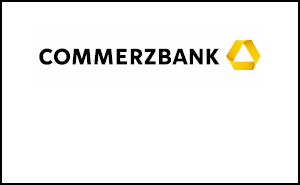
 Gold was in greater demand as a safe haven again yesterday and climbed by over 1.5% for a time to $1,310 per troy ounce on the back of increased tensions in the Ukraine-Russia conflict. Representatives of the Polish and US governments, and of NATO, appeared concerned that Russia, having noticeably stepped up its military presence near the border to Ukraine, might invade its neighbour on the pretext of wishing to secure peace. The fact that yields on 10-year US government bonds fell yesterday to their lowest level since the end of May also played their part in the price rise. Silver has been pulled upwards in gold’s slipstream and has exceeded the $20 per troy ounce mark again. In the short term, gold in particular should remain well-supported by the geopolitical risks, though continued weak physical demand is likely to weigh on prices. Following subdued gold demand in China and India, Turkey also reported weak import figures yesterday: in July, gold imports declined to just 1.5 tons, putting them at their lowest level since February. Compare this to the month before, when 24.3 tons of gold were imported. Today will see investors focus on the ECB meeting, though we do not expect any surprises from it. Additional stimulus measures appear somewhat unlikely in the near future, and ECB President Draghi will probably address the low inflation rate in the press conference.
Gold was in greater demand as a safe haven again yesterday and climbed by over 1.5% for a time to $1,310 per troy ounce on the back of increased tensions in the Ukraine-Russia conflict. Representatives of the Polish and US governments, and of NATO, appeared concerned that Russia, having noticeably stepped up its military presence near the border to Ukraine, might invade its neighbour on the pretext of wishing to secure peace. The fact that yields on 10-year US government bonds fell yesterday to their lowest level since the end of May also played their part in the price rise. Silver has been pulled upwards in gold’s slipstream and has exceeded the $20 per troy ounce mark again. In the short term, gold in particular should remain well-supported by the geopolitical risks, though continued weak physical demand is likely to weigh on prices. Following subdued gold demand in China and India, Turkey also reported weak import figures yesterday: in July, gold imports declined to just 1.5 tons, putting them at their lowest level since February. Compare this to the month before, when 24.3 tons of gold were imported. Today will see investors focus on the ECB meeting, though we do not expect any surprises from it. Additional stimulus measures appear somewhat unlikely in the near future, and ECB President Draghi will probably address the low inflation rate in the press conference.
Analys
OPEC+ won’t kill the goose that lays the golden egg

Lots of talk about an increasingly tight oil market. And yes, the oil price will move higher as a result of this and most likely move towards USD 100/b. Tensions and flareups in the Middle East is little threat to oil supply and will be more like catalysts driving the oil price higher on the back of a fundamentally bullish market. I.e. flareups will be more like releasing factors. But OPEC+ will for sure produce more if needed as it has no interest in killing the goose (global economy) that lays the golden egg (oil demand growth). We’ll probably get verbal intervention by OPEC+ with ”.. more supply in H2” quite quickly when oil price moves closer to USD 100/b and that will likely subdue the bullishness. OPEC+ in full control of the oil market probably means an oil price ranging from USD 70/b to USD 100/b with an average of around USD 85/b. Just like last year.

Brent crude continues to trade around USD 90/b awaiting catalysts like further inventory declines or Mid East flareups. Brent crude ydy traded in a range of USD 88.78 – 91.1/b before settling at USD 90.38/b. Trading activity ydy seems like it was much about getting comfortable with 90-level. Is it too high? Is there still more upside etc. But in the end it settled above the 90-line. This morning it has traded consistently above the line without making any kind of great leap higher.
Netanyahu made it clear that Rafah will be attacked. Israel ydy pulled some troops out of Khan Younis in Gaza and that calmed nerves in the region a tiny bit. But it seems to be all about tactical preparations rather than an indication of a defuse of the situation. Ydy evening Benjamin Netanyahu in Israel made it clear that a date for an assault on Rafah indeed has been set despite Biden’s efforts to prevent him doing so. Article in FT on this today. So tension in Israel/Gaza looks set to rise in not too long. The market is also still awaiting Iran’s response to the bombing of its consulate in Damascus one week ago. There is of course no oil production in Israel/Gaza and not much in Syria, Lebanon or Yemen either. The effects on the oil market from tensions and flareups in these countries are first and foremost that they work as catalysts for the oil price to move higher in an oil market which is fundamentally bullish. Deficit and falling oil inventories is the fundamental reason for why the oil price is moving higher and for why it is at USD 90/b today. There is also the long connecting string of:
[Iran-Iraq-Syria/Yemen/Lebanon/Gaza – Israel – US]
which creates a remote risk that oil supply in the Middle East potentially could be at risk in the end when turmoil is flaring in the middle of this connecting string. This always creates discomfort in the oil market. But we see little risk premium for a scenario where oil supply is really hurt in the end as neither Iran nor the US wants to end up in such a situation.
Tight market but OPEC+ will for sure produce more if needed to prevent global economy getting hurt. There is increasing talk about the oil market getting very tight in H2-24 and that the oil price could shoot higher unless OPEC+ is producing more. But of course OPEC+ will indeed produce more. The health of the global economy is essential for OPEC+. Healthy oil demand growth is like the goose that lays the golden egg for them. In no way do they want to kill it with too high oil prices. Brent crude averaged USD 82.2/b last year with a high of USD 98/b. So far this year it has averaged USD 82.6/b. SEB’s forecast is USD 85/b for the average year with a high of USD 100/b. We think that a repetition of last year with respect to oil prices is great for OPEC+ and fully acceptable for the global economy and thus will not hinder a solid oil demand growth which OPEC+ needs. Nothing would make OPEC+ more happy than to produce at a normal level and still being able to get USD 85/b. Brent crude will head yet higher because OPEC+ continues to hold back supply Q2-24 resulting in declining inventories and thus higher prices. But when the oil price is nearing USD 100/b we expect verbal intervention from the group with statements like ”… more supply in H2-24” and that will probably dampen bullish prices.
Not only does OPEC+ want to produce at a normal level. It also needs to produce at a normal level. Because at some point in time in the future there will be a situation sooner or later where they will have to cut again. And unless they are back to normal production at that time they won’t be in a position to cut again.
So OPEC+ won’t kill the goose that lays the golden egg. They won’t allow the oil price to stay too high for too long. I.e. USD 100/b or higher. They will produce more in H2-24 if needed to prevent too high oil prices and they have the reserve capacity to do it.
Data today: US monthly oil market report (STEO) with forecast for US crude and liquids production at 18:00 CET
Analys
Prepare for more turmoil, lower inventories and higher prices

Brent crude is pulling back below the 90-line this morning trading as low as USD 88.78/b following a 4.2% gain last week. The pullback is blamed on news that Israel is pulling some troops out of Gaza. But we think this is much more of a technical move below the 90-line with preparations for further price gains ahead. The Israeli troop movements are a preparation for a final push into Rafah in Gaza to take out the last stronghold of Hamas there (FT article today). Iranian retaliation following the attack in Damascus last week also looks set to unfold in some way. Possibly by Hezbollah in Lebanon though instigated by Iran. Prepare for more turmoil, lower oil inventories and higher prices as the market continues to run a deficit.

Brent gained 4.2% last week with a solid close above the 90-line. Brent crude had a stellar week last week gaining 4.2%. Even following such a strong performance it made a gain on Friday of 0.6% with a close at USD 91.17/b. Friday also saw the highest trade of the week at USD 91.91/b.
Brent was propelled by positive PMI gains, geopolitics and falling US inventories. Oil was supported by a rang of factors last week. Both the US and China saw their manufacturing PMIs rise above the 50-line (50.3 and 50.8 resp.). The Eurozone manufacturing PMI rose to 46.1 from 45.7 while the composite index rose above the 50-line to 50.3 from 49.9. These PMI gains supported both oil and metals through growth recovery optimism. US oil inventories last Wednesday created less waves with a net draw of 2.2 m b in total crude and product inventories. It was still a very bullish reading in our view as inventories normally this time of year should have risen 3.8 m b. Thus driving US commercial oil inventories further away and below the normal level of inventories. Geopolitical focus flared up following the attack on Iran’s consulate in Syria where Iran’s top Islamic Revolutionary Guard Corps (IRGC) general in Syria along with five other IRGC officers were killed. Israel is assumed to be behind the attack but has not taken responsibility yet.
Back below 90 this morning in what seems like a geopolitical breather. But is more of a technical move. This morning Brent crude has pulled back and traded as low as USD 88.78/b while trading at USD 89.76/b. We commented on Friday that it is quite normal for Brent crude to pull back below big numbers after having broken them. Just to test out the level properly before heading higher.
Israel is pulling some troops out of Gaza. Most likely it is preparing to attack Rafah (FT today). Price action to the downside this morning is blamed on some kind of reduced geopolitical premium as Israel is withdrawing some of its troops in Gaza. The reason why it is withdrawing some tropes however is to our understanding that Israel is preparing to attack Rafah, the southernmost part of Gaza bordering to Egypt where now close to one million Palestinians are living. It is the last strong-hold of Hamas and Israel looks bent on taking it out despite repeated warnings against it from the US. Human tragedy looks set to unfold in Rafah in not too long.
”Iran will respond to the Damascus strike”. The most likely flareup is Lebanon and Hezbollah. The geopolitical flare following the attack on Iran’s consulate in Syria last week has faded a little this morning. But this is in no way over. John Sawers, former chief of MI6, in an article in FT on Friday bluntly stated: ”Iran will respond to the Damascus strike”. Iran still doesn’t want to be involved in direct military confrontation. The likely flareup will be Lebanon and Hezbollah which could force Israel into a two-front war.
Rafah is located in the southernmost part of Gaza
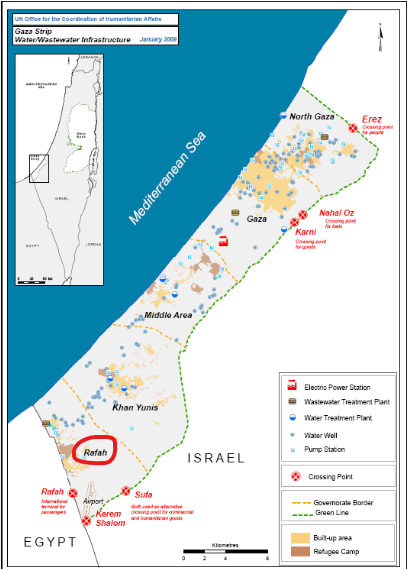
Net long specs in Brent + WTI rose by 34 m b over the week to 2 April.
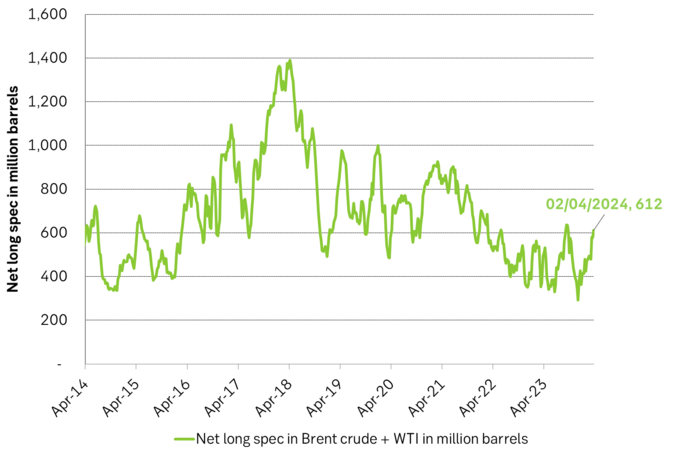
Saudi Arabia lifted its Official Selling Prices to Asia for most grades for May delivery
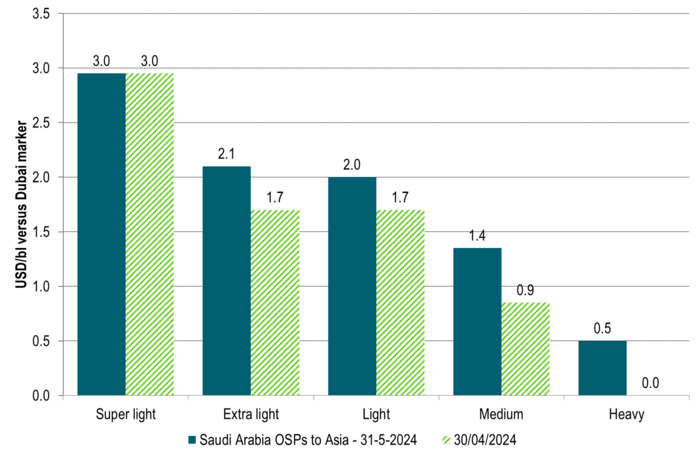
Analys
Brent crude jumps above USD 91/b as market nervously brace for Iranian retaliation

Brent crude jumps above USD 91/b but will likely see sub-90 again before charging yet higher. Brent crude reached USD 89.99/b on Wednesday before making the leap above the 90-line yesterday evening in a spiky fashion jumping almost directly to USD 91.3/b (ydy high) in less than three hours before closing at USD 90.65/b. This morning it is showing strength again with a gain of 0.6% to USD 91.2/b though it hasn’t yet broken above the high from ydy. It is very usual for the oil price to fool around big numbers as the 90-line before properly breaking through. We saw it on Wednesday when it almost got there but not really above anyhow. Also after breaking properly above as it did yesterday one often sees that the oil price then dips down to the ”big number” again, a little bit below, just to test it, before properly breaking higher. Thus we’ll likely see it break down below the 90-line again in the short-term before heading properly higher.

Iran promises retaliation while Israel makes it clear it will strike back if attacked. Iran’s top Islamic Revolutionary Guard Corps (IRGC) general in Syria along with five other IRGC officers were killed on Monday following an attack on Iran’s consulate in Syria. Iran has blamed Israel for the attack. Israel has so far not taken responsibility for the attack. Iran’s President Ebrahim Raisi directly blamed Israel and stated on Tuesday that Israel’s strike on its consulate in Syria ”won’t remain unanswered”. Yesterday we saw a hard-line stand from Israel where Netanyahu made it clear that if Iran strikes its territory then Israel will have no choice but to respond.
Market is preparing for Iranian retaliation, but most likely it will be through Iran’s proxies. The market is now bracing it self for a likely retaliatory action by Iran in response to the event in Syria on Monday. It seems very unlikely that Iran explicitly will attack targets on Israeli soil directly and thus risk getting dragged into a wider war with Israel and thus the US. If Israel and Iran gets into a direct conflict then the US will naturally be involved either directly or indirectly. No one wants that. Not Iran, not Biden and not Israel. A forthcoming retaliatory attack from Iran will thus likely be through some of its proxies in Yemen, Syria or Lebanon.
The market now know that some kind of retaliation from Iran will likely come but it doesn’t know when and where and what and that creates a great discomfort and nervousness.
Oil supply is unlikely to be affected. Still no one expects that oil supply is at risk in any way unless this situation blows out to an all-engulfing conflict between Israel and Iran where the US naturally would be dragged along into it all. It is too much at stake for all parties involved for this to happen.
Iran is producing 3.1 m b/d and rising and is unlikely to endanger that. Iran is probably extremely happy at the moment with respect to oil prices and oil exports. Iran used to produce around 3.8 m b/d of crude oil but due to US sanctions it only produced 2.0 m b/d in 2020 which is basically what it needs to cover its own demand with little left over for exports except for condensates which comes on top of crude oil production with about 0.8 m b/d. Since 2020 however its production has increased significantly and now stands at 3.1 m b/d and rising. Add in an oil price of USD 91/b and the situation for Iran is close to bliss economically. So Iran will likely retaliate following the attack on its consulate in Syria on Monday, but not in a fashion which will endanger its greatly improved situation with respect to oil export income.
Iran’s oil production is now back up to 3.1 m b/d and rising. Economically this is bliss for Iran when added together with an oil price of USD 91/b
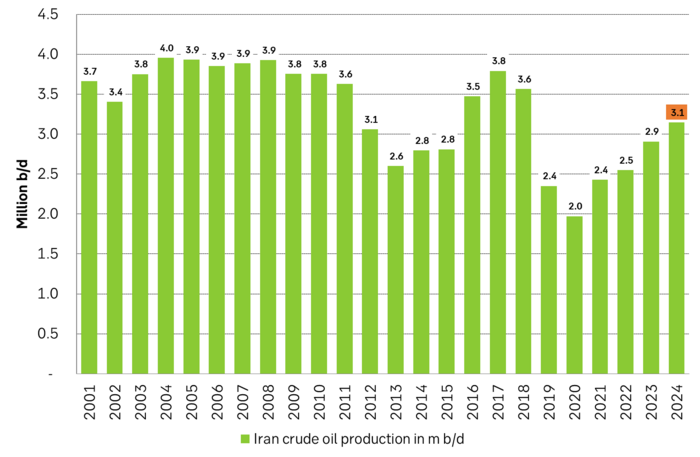
The ongoing destruction of Gaza following the October 7 attack on Israel will feed red hot anger, pain and violence into the Middle East region for months and years to come.

-

 Nyheter4 veckor sedan
Nyheter4 veckor sedanMichel Rufli om trenderna som får guldpriset att stiga
-

 Nyheter4 veckor sedan
Nyheter4 veckor sedanGuld toppar 2200 USD per uns
-

 Nyheter3 veckor sedan
Nyheter3 veckor sedanVertikal prisuppgång på kakao – priset toppar nu 9000 USD
-

 Nyheter3 veckor sedan
Nyheter3 veckor sedanLundin Mining får köprekommendation av BMO
-

 Nyheter2 veckor sedan
Nyheter2 veckor sedanGuldpriset når nytt all time high och bryter igenom 2300 USD
-

 Nyheter3 veckor sedan
Nyheter3 veckor sedanKaffepriserna stiger på lågt utbud och stark efterfrågan
-

 Nyheter2 veckor sedan
Nyheter2 veckor sedanCentralbanker fortsatte att köpa guld under februari
-

 Nyheter4 veckor sedan
Nyheter4 veckor sedanPriset på koppar i Shanghai når treårshögsta efter minskad oro för Kinas produktion







